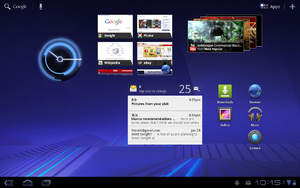Android Honeycomb
| A version of the Android operating system | |
 | |
 Android 3.0 running on a Motorola Xoom | |
| Developer | |
|---|---|
| Initial release | February 22, 2011 |
| Latest release | 3.2.6 / February 15, 2012 |
| Kernel type | Monolithic Kernel (Linux Kernel) |
| License | Proprietary software[1] |
| Preceded by | Android 2.3.7 "Gingerbread" |
| Succeeded by | Android 4.0 "Ice Cream Sandwich" |
| Official website | developer |
| Support status | |
| Unsupported | |
Android Honeycomb is the codename for the third version of Android, designed for devices with larger screen sizes, particularly tablets. It is the third major release of Android and is no longer supported. Honeycomb debuted with the Motorola Xoom in February 2011.[2][3] Besides the addition of new features, Honeycomb introduced a new so-called "holographic" user interface theme and an interaction model that built on the main features of Android, such as multitasking, notifications and widgets.[4][5]
Features[]
New features introduced in Honeycomb include the following:
- The Email and Contacts apps use a two-pane UI.
- The Gallery app now lets users view albums and other collections in full-screen mode, with access to thumbnails for other photos in a collection.
- The Browser app replaces browser windows with tabs, adds an incognito mode for anonymous browsing, and presents bookmarks and history in a unified view, among other features.
- A redesigned keyboard to make entering text easier on large-screen devices such as tablets.
- A Recent Apps view for multitasking.
- Customizable home screens (up to five).
See also[]
- Android version history
References[]
- ^ Metz, Cade (March 24, 2011). "Steve Jobs vindicated: Google Android is not open". Retrieved June 23, 2018.
- ^ "What is Android 3.0 Honeycomb? - Definition from WhatIs.com". Retrieved July 29, 2016.
- ^ "Google announces Android 3.1, available on Verizon Xoom today". Engadget. Engadget. Retrieved July 29, 2016.
- ^ "The history of Android". Ars Technica. Retrieved September 13, 2015.
- ^ John Brandon. "Android 3.0 (Honeycomb) review". TechRadar. Retrieved September 13, 2015.
Categories:
- Android (operating system)
- 2011 software
- Operating system stubs
